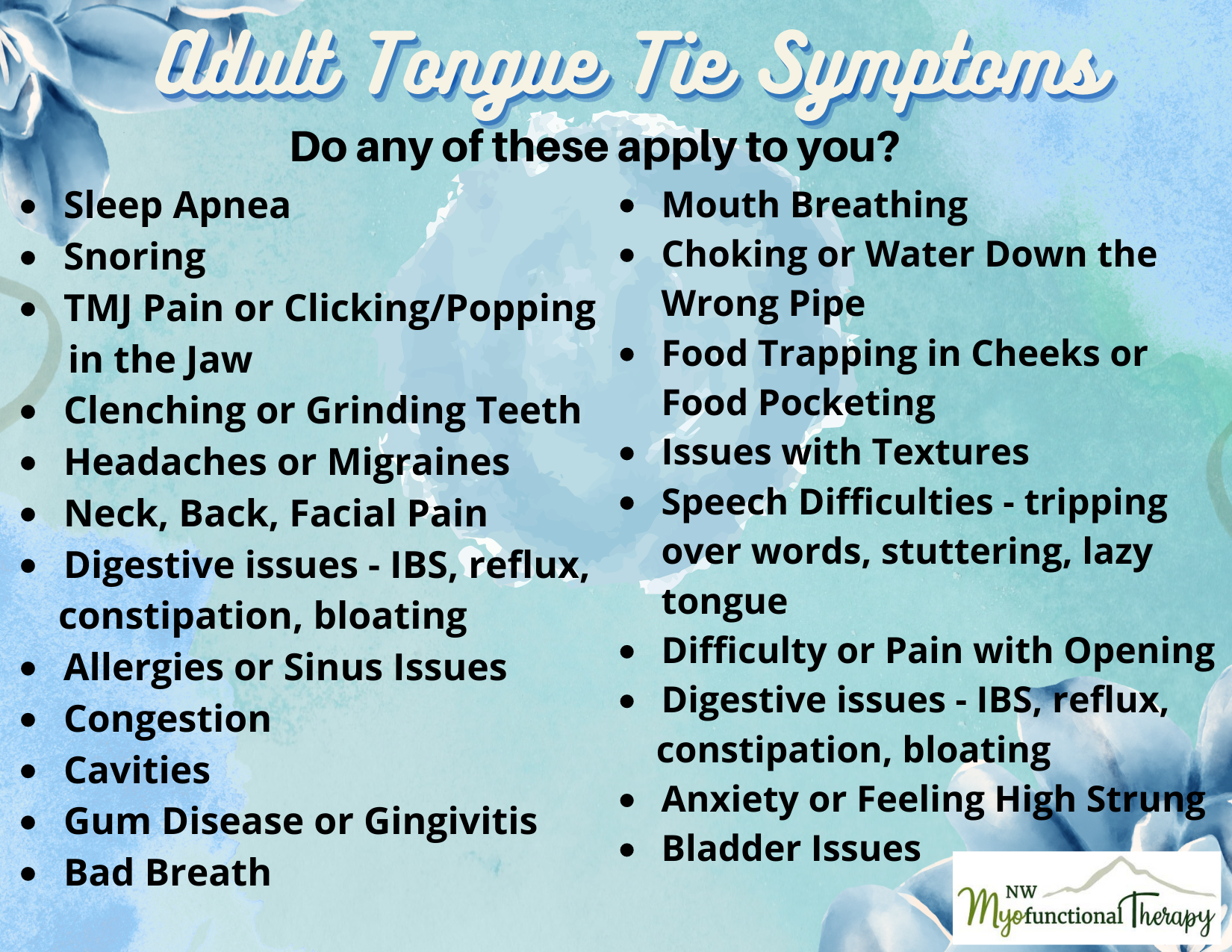What is a Tongue-Tie?
Do you snore? Clench or grind your teeth? Do you get headaches? Jaw Pain? What about migraines? Is it hard to say certain words? Difficulties with ADHD or ADD? Overall body tension? Breathe through your mouth? You could be tongue-tied.
A tongue-tie involves the string of tissue that connects your tongue to the floor of the mouth. This string of tissue is called a frenum and everyone has one. For some people, that string is tighter than it should be and can be the source of many problems in your mouth and throughout your body.
There are two types of tongue-ties, anterior and posterior. Anterior tongue ties are the more obvious of the two types. It’s easily diagnosed because it can be seen right away when you lift the tongue up. The underside of the tongue is connected too tightly to the floor of the mouth, and that the range of motion is restricted. Posterior tongue-ties are a little more challenging to identify. They are more often symptom-based or can be hidden by the floor of the mouth compensating to help the tongue function. To learn more about posterior tongue-ties you can click here.
Why Does A Tongue-Tie Matter?
We all have a lingual frenum (or frenulum). This is the line of tissue that runs under the tongue that connects the tongue to the floor of the mouth. In some people, as I mentioned above, it’s restricted, which is why a tongue-tie is also known as a restricted lingual frenum, and sometimes as tethered oral tissue. This restriction can prevent the tongue from moving correctly or from resting in the right place. This can in turn cause a number of symptoms and functional limitations depending on how bad it is.
Tongue position is really important when it comes to our overall health! The tongue should fill up the entire roof of the mouth from front to back. When it’s in this position, it provides a support structure for the upper jaw. When the tongue is in the right place, teeth grow in straighter and the face develops optimally. But a tongue-tie means that the tongue is literally unable to reach the palate all the way, if at all. So it rests in the bottom of your mouth, which is dysfunctional.

People who are tongue-tied often mouth breathe. This leads to a wide range of myofunctional problems and symptoms. Chronic jaw pain, sleep apnea, facial pain, headaches, and clenching and grinding, along with dental and orthodontic issues are common in people with tongue-ties. Research shows that tongue-tied children are at higher risk to develop sleep apnea and airway issues, and their facial and cranial development is also impacted.
What Can I Do To Help?
If you have a tongue-tie, you need a simple procedure known as a frenectomy. During my assessments, I evaluate every patient to confirm whether or not the procedure would be beneficial. If the frenectomy surgery is needed, then it is crucial to prepare with exercises both before and after to get the best results. Once the surgery is complete, it is vital to meet with me within the first 24 hours to check the healing and teach additional exercises to strengthen and gain muscle control over the tongue’s new mobility. Re-training the tongue is a crucial step to the process because the muscles in the tongue have never properly been used. These muscles need to be trained and activated through myofunctional therapy to keep the tongue from re-attaching to the original place. I have seen many patients need to have a second procedure, because they did not prepare for the first.
I will help you coordinate your exercise sessions with your doctor performing the procedure so your treatment is perfectly timed.
Tongue-Tie Symptoms in Babies
Breastfeeding problems are often linked to tongue-tie concerns in babies. Sometimes, a tongue-tied baby may be able to breastfeed without any trouble, so it may go undiagnosed or recognized.
The restriction caused by a tongue-tie can lead to changes in the development of the mouth, face, and skull, often accompanied with an open mouth resting posture or mouth breathing in children. This can in turn lead to symptoms including speech difficulties, ADD and ADHD, sleep disordered breathing conditions such as sleep apnea, and jaw and facial pain and tension.
The International Journal of Pediatric Research said it best:
Children with untreated short frenulum developed abnormal tongue function early in life with secondary impact on orofacial growth and sleep disordered breathing (SDB). The changes in orofacial growth related to factors including short lingual frenulum lead to SDB and mouth breathing very early in life. Recognition and treatment of short frenulum early in life – at birth if possible – would improve normal orofacial growth.
Addressing the tongue-tie from the start could save you a lot of health problems into adulthood. Being proactive is the key.
People who are tongue-tied often mouth breathe. This leads to a wide range of myofunctional problems and symptoms. Chronic jaw pain, sleep apnea, facial pain, headaches, and clenching and grinding, along with dental and orthodontic issues are common in people with tongue-ties. Research shows that tongue-tied children are at higher risk to develop sleep apnea and airway issues, and their facial and cranial development is also impacted.
Often, healthcare professionals dealing with tongue-ties perform a minor surgical procedure to release the frenum. This is called a frenectomy or a frenulotomy. It was sometimes done with a laser, or with a scalpel or scissors. More recently, Los Angeles-based Dr. Soroush Zhagi has developed an even more effective technique for the tongue-tie release procedure. His new approach has proven to provide patients with amazing results. Dr. Zaghi’s Breathe Institute website summarizes the functional frenuloplasty best: “We have a multidisciplinary protocol of functional frenuloplasty that integrates myofunctional therapy (and sometimes craniosacral therapy) both before, during, and after surgery. Our technique is based on precision: releasing the appropriate extent of tissues for maximal relief; not too much, and not too little. Scalpel and/or scissors causes no thermal tissue damage as compared to laser and allows for the placement of sutures to promote healing by primary intention. We find that leaving the wound open to heal by secondary intention (without sutures) predisposes to excessive scarring.” I have had many patients over the last few years have excellent results from the functional frenuloplasty. Their results are lasting and have minimal, if any, reattachment. The number of doctors and dentists performing the functional frenuloplasty is growing month by month. This is great for my patients because I’ve got a growing referral network to refer them to for a tongue-tie release. Whether it is a functional frenuloplasty or a frenectomy, the most important thing to know about tongue-tie releases is that the skill and experience of the person doing the procedure are still by far the most important factors in getting a good result.
Did you know there are two types of tongue-ties? Anterior tongue ties are the more obvious of the two types. It’s easily diagnosed because your doctor can see it right away when you lift the tongue up. The underside of the tongue is connected too tightly to the floor of the mouth, and that the range of motion is restricted. Posterior tongue-ties aren’t obvious at first glance. The back part of the tongue is restricted rather than the front portion of the tongue and the restriction is totally different. Posterior tongue-ties can be difficult to diagnose because the other muscles of the face and mouth compensate for the restriction. One clue I look at is the floor of the mouth lifting up to allow the tongue to move to the palate. Often people with this tie can stick their tongue out a long way or get the front or the whole tongue to rest on the top of the mouth. However, when these muscles compensate, we see pain and tension all throughout the neck, face, jaw, shoulders, and more. This can lead to clenching, grinding, TMJ problems, postural problems, as well as sleep apnea or other sleep disordered breathing conditions. Babies with a posterior tongue-tie may also have difficulty breastfeeding.
In my experience, I often hear patients struggle to make the correct R and L sounds. These sounds are linked to tongue-ties, because of the specific movements of the tongue needed to make the sound. When you are tongue-tied, your tongue isn’t able to elevate to the roof of the mouth to create those sounds easily.
In the mouth, there are seven small bands of muscles called frenums. Their role is to help the lips and tongue function together with the bones during facial development. The band of muscle that attaches to the tongue is known as the lingual frenum. It connects the tongue to the floor of the mouth. Sometimes the band is too short which causes a restriction in the tongue’s ability to move which is more commonly known as a tongue-tie. It is also referred to as a “restricted lingual frenum” or “tethered oral tissue.” The physical limitation of muscle movement can impact oral development and dental health including swallowing, speech, and correct tongue movement, causing bone loss, TMD, orthodontic relapse, clenching, and grinding which can contribute to sleep apnea symptoms. It unfortunately cannot be corrected by habit or oral exercises alone. A tongue-tie can be corrected or released through a procedure called a frenectomy performed by a dentist, oral surgeon, or ENT. A myofunctional therapist aids in providing exercises for the tongue before and after the frenectomy. The tissue might reattach if the muscles aren’t strengthened and retrained properly. These exercises also teach the patient to breathe properly through their nose, especially at night.

